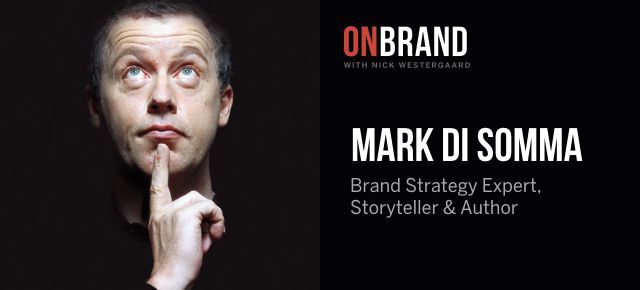Podcast: Play in new window | Download
“The expression of your brand strategy should excite the customer.” For Mark Di Somma, brand strategy is as much a creative process as a logical one. It’s about making decisions that enable a brand to change how it’s valued by the people who buy its products and by those who work so hard from the inside to bring the brand to life. It’s about being interesting and staying interesting in a world where attention quickly flags. I couldn’t wait to discuss all of this on this week’s On Brand podcast.
Enjoy This Episode Now
About Mark Di Somma
Mark Di Somma works alongside brand owners and communicators to define, articulate, and elevate the competitive value of their brands at critical moments of change. For Mark, brand is a lens – a very powerful lens – through which to look at how competitive a business is, how well a brand culture works and why people will choose to pay above the market rate for your products.
Di Somma started working in advertising, direct marketing, and the design industry as a writer and creative consultant. Today he works on projects for companies of all sizes, in situations ranging from start-up to revival and rescue. He was part of the team that defined New Zealand’s national tourism branding. He rewrote the brand language of Vodafone. He led a creative team that completely rewrote every aspect of AAPT’s customer contact programme in Australia. He was a founding contributor to, and later editor of, the global brand reference site All About Branding.
Di Somma regularly shares his thinking and learnings on his blog Upheavals, on platforms such as Branding Strategy Insider and as a brand strategy keynote speaker at conferences.
Episode Highlights
Brand vs. branding strategy. This week we simplified a lot of vocabulary we’re constantly using in the complex world of branding. Mark began by noting that “Brand is what you’re looking to build. Branding is how you’re going to build it. The expression of your brand strategy should excite the customer.”
What skills are most important for brand strategists? “There are four strong drivers,” Mark went on to share them in no particular order. A brand strategist has to understand, “humanity, finance, competitiveness, and creativity.
“Only 25% of brands are seen as distinctive by customers. The rest blend into the mush. You have to build an understanding both inside your walls and outside of your walls. You have to build something people want to interact with. They should interact with your brand instead of just transacting with you.”
What role does story play in brand strategy? Mark again clarified that too often we confuse story with news, narrative, and prose. “A brand’s story should express your journey. A brand’s journey is how you achieve your purpose.” Brand stories come in various forms, at various times. You have your long story such as Google’s on-going quest for information accessibility. From there you have shorter stories — chapters, episodes. “Social media has made even smaller stories.”
What brand has made Mark smile recently? It was a big week on the podcast — Mark shared six (!) brands that make him smile consistently. “Diesel for their cheeky-ness, Apple as the only luxury brand in technology, Volvo (trucking) for telling entertaining stories in B2B, Disney for their commitment to magic, and Channel and Burberry for building story brands in the fast-moving world of fashion.”
To learn more about Mark, check out MarkDiSomma.com. You can also follow on Twitter. You can also read his posts at Branding Strategy Insider.
As We Wrap …
Before we go, I want to flip the microphone around to our community …
Our friends over at Blab who liked our recent episode featuring social video expert Brian Fanzo. Thanks for listening!
Did you hear something you liked on this episode or another? Do you have a question you’d like our guests to answer? Let me know on Twitter using the hashtag #OnBrandPodcast and you may just hear your thoughts here on the show.
Last but not least …
- Subscribe to the podcast – You can subscribe to the show via iTunes, Stitcher, and RSS.
- Rate and review the show – If you like what you’re hearing, head over to iTunes and click that 5-star button to rate the show. And if you have a few extra seconds, write a couple of sentences and submit a review. This helps others find the podcast.
- OK. How do you rate and review a podcast? Need a quick tutorial on leaving a rating/review in iTunes? Check this out.
Until next week, I’ll see you on the Internet!


